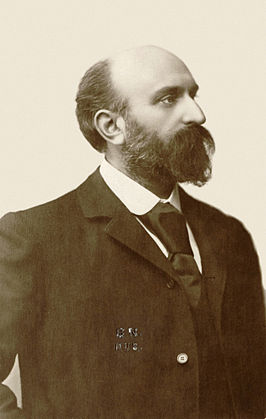Amedee-Ernest Chausson (1855-1899).
- Profession: Composer, lawyer.
- Residences: Paris.
- Relation to Mahler:
- Correspondence with Mahler:
- Born: 20-01-1855 Paris, France.
- Died: 10-06-1899 Limay, France.
- Buried: 00-00-0000 Pere Lachaise cemetery, Paris, France.
Amédée-Ernest Chausson was a French romantic composer who died just as his career was beginning to flourish. Born in Paris into an extremely affluent bourgeois family, Ernest Chausson was the sole surviving child of a building contractor who had made his fortune assisting Baron Haussmann in the redevelopment of Paris in the 1850s. To please his father, Chausson studied law and was appointed a barrister for the Court of Appeals, but had little or no interest in the profession. He frequented the Paris salons, where he met celebrities such as Henri Fantin-Latour, Odilon Redon, and Vincent d’Indy. Before deciding on a musical career, he dabbled in writing and drawing.
In 1879, at the age of 24, he began attending the composition classes of Massenet at the Paris Conservatoire; Massenet came to regard him as ‘an exceptional person and a true artist’. Chausson had already composed some piano pieces and songs. Nevertheless, the earliest manuscripts that have been preserved are those corrected by Massenet. At the Paris Conservatoire, Chausson also studied with César Franck, with whom he formed a close friendship that lasted until Franck’s death in 1890. Chausson interrupted his studies in 1881, after a failed attempt to win the Prix de Rome.
During 1882 and 1883, Chausson, who enjoyed travel, visited Bayreuth to hear the operas of Wagner. On the first of these journeys, Chausson went with d’Indy for the premiere of Wagner’s Parsifal, and on the second trip he went with his new spouse Jeanne Escudier (1862-1936), with whom he was to have five children. From 1886 until his death in 1899, Chausson was secretary of the Société Nationale de Musique.
In his own home (22 Boulevard de Courcelles, near Parc Monceau), he received a great many eminent artists, including the composers Henri Duparc, Gabriel Fauré, Claude Debussy, and Isaac Albéniz, the poet Mallarmé, the Russian novelist Turgenev, and the impressionist painter Monet. Chausson also assembled an important collection of paintings.
More
Born in Paris into an extremely affluent bourgeois family, Ernest Chausson was the sole surviving child of a building contractor who had made his fortune assisting Baron Haussmann in the redevelopment of Paris in the 1850s. To please his father, Chausson studied law and was appointed a barrister for the Court of Appeals, but had little or no interest in the profession. He frequented the Paris salons, where he met celebrities such as Henri Fantin-Latour, Odilon Redon, and Vincent d’Indy. Before deciding on a musical career, he dabbled in writing and drawing.
In 1879, at the age of 24, he began attending the composition classes of Massenet at the Paris Conservatoire; Massenet came to regard him as ‘an exceptional person and a true artist’. Chausson had already composed some piano pieces and songs. Nevertheless, the earliest manuscripts that have been preserved are those corrected by Massenet. At the Paris Conservatoire, Chausson also studied with César Franck, with whom he formed a close friendship that lasted until Franck’s death in 1890. Chausson interrupted his studies in 1881, after a failed attempt to win the Prix de Rome.
During 1882 and 1883, Chausson, who enjoyed travel, visited Bayreuth to hear the operas of Wagner. On the first of these journeys, Chausson went with d’Indy for the premiere of Wagner’s Parsifal, and on the second trip he went with his new spouse Jeanne Escudier (1862-1936), with whom he was to have five children.
From 1886 until his death in 1899, Chausson was secretary of the Société Nationale de Musique. In his own home (22 Boulevard de Courcelles, near Parc Monceau), he received a great many eminent artists, including the composers Henri Duparc, Gabriel Fauré, Claude Debussy, and Isaac Albéniz, the poet Mallarmé, the Russian novelist Turgenev, and the impressionist painter Monet. Chausson also assembled an important collection of paintings.
When only 44 years old, Chausson died while staying at one of his country retreats, the Château de Mioussets, in Limay, Yvelines. Riding his bicycle downhill, Chausson hit a brick wall and died instantly. The exact circumstances remain unclear; although probably a freak accident, there has been the suggestion of suicide, as Chausson was certainly prone to depression.
This suicide theory was propounded by Debussy’s biographer Edward Lockspeiser, but has been firmly rejected more recently by Chausson’s own biographer Ralph Scott Grover.
Chausson was buried in Père Lachaise Cemetery in Paris. His funeral was attended by many leading figures of the arts, including Duparc, Fauré, Albeniz, Redon, Edgar Degas, Auguste Rodin, Henri de Régnier, Pierre Louÿs and Debussy. While Chausson’s brotherly relationship with Debussy had ended abruptly five years earlier, following his disapproval of Debussy’s promiscuity, Debussy never ceased to admire Chausson’s music.

